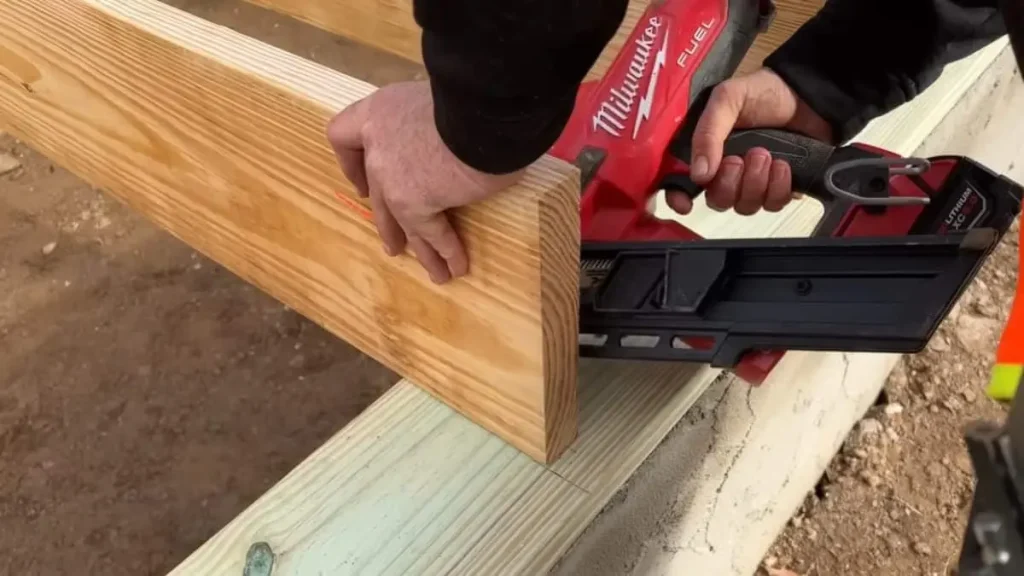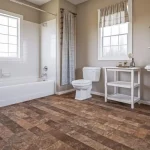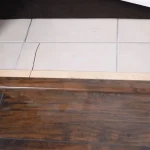Attaching floor joists to a sill plate is a critical step in ensuring the structural integrity of your home. Floor joists provide essential support for the floors above, while the sill plate anchors the entire structure to the foundation. Whether you’re building a new home or repairing an existing one, understanding how to correctly attach floor joists to the sill plate is crucial for safety and long-term durability.
This comprehensive guide will walk you through the process, covering everything from the tools and materials needed to best practices and common issues to avoid. With clear, step-by-step instructions, even DIY enthusiasts can confidently complete this task and ensure a solid, stable foundation for their project.
What Are Floor Joists and Sill Plates?

Floor joists are horizontal structural members used in construction to support the flooring of a building. They span the distance between walls or beams, transferring the load of the floor and any furnishings or occupants above to the foundation or supporting walls below. Typically made from wood, engineered wood, or metal, floor joists are essential for maintaining the structural integrity and stability of a home.
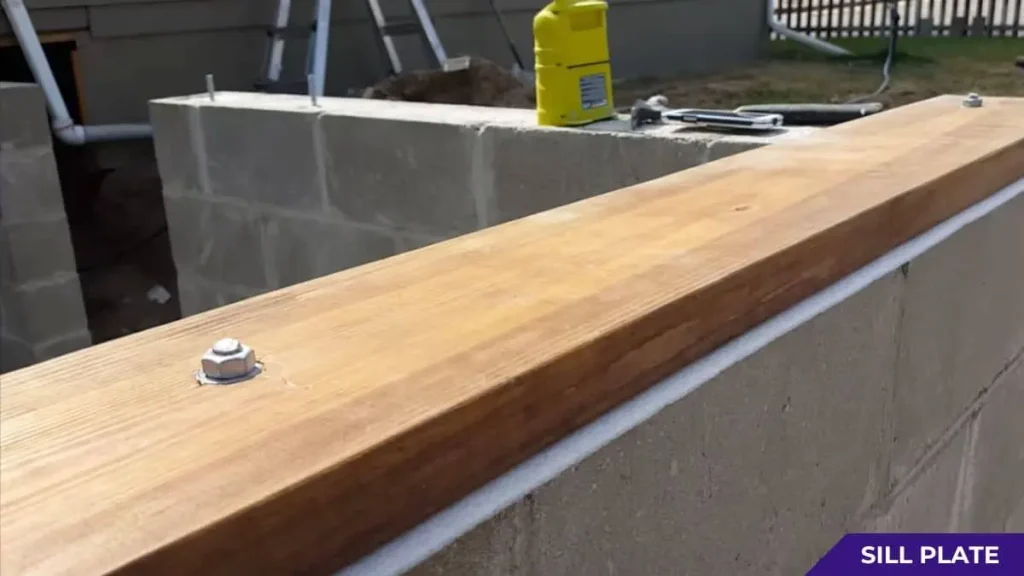
Sill plates, also known as mudsills, are horizontal wooden beams that sit on top of the foundation wall. They serve as the anchor point for the entire structure, providing a stable base for the floor framing. Sill plates help to prevent moisture from the foundation from entering the wooden components of the house, acting as a barrier against dampness. Properly installing and securing sill plates is crucial for ensuring that the entire framing system remains sound and that the building maintains its structural integrity over time.
What Tools and Materials Do You Need to Attach Floor Joists to a Sill Plate?

Before starting, gather the necessary tools and materials. Having everything on hand will make the process more efficient and help prevent delays.
- Hammer or nail gun – for driving nails or screws
- Joist hangers – to secure the joists to the sill plate
- Galvanized nails or screws – corrosion-resistant fasteners for a secure hold
- Measuring tape – for accurate placement of joists
- Level – to ensure the floor is even
- Pencil or chalk line – to mark joist positions
- Safety gear – gloves, safety glasses, and ear protection
Preparation and Safety Tips
Before beginning any construction project, including attaching floor joists to a sill plate, proper preparation and safety measures are essential. Ensuring that your work environment is ready and following safety protocols can prevent accidents and lead to a smoother installation process.

How Should You Prepare the Work Area?
Preparing the work area is a crucial step to avoid unnecessary delays or hazards during the installation. First, clear the space of any debris, tools, or materials that could cause tripping or obstruct movement. Ensure there is adequate lighting, especially in areas such as basements or crawl spaces where visibility can be low. This helps you see clearly when making precise measurements and attachments.
Additionally, ensure the sill plate is level and securely anchored to the foundation before proceeding with any joist work. A sill plate that isn’t level or properly installed will lead to uneven floors, which can cause structural issues over time. Double-checking the alignment at this stage will save you from correcting mistakes later.
Why Is Wearing Protective Gear Important?
Wearing protective gear is a non-negotiable aspect of any construction project. Eye protection, such as safety glasses, is critical to shield your eyes from flying debris when hammering or cutting. Always wear gloves to protect your hands from sharp edges on metal joist hangers or splinters from the wood. If using a nail gun or other power tools, ear protection is recommended to guard against long-term hearing damage from prolonged exposure to loud noises.
In addition to these, sturdy footwear is essential to prevent foot injuries. Steel-toed boots are particularly effective in protecting against dropped tools or heavy materials while providing better grip on potentially slippery surfaces.
How Can You Ensure Structural Safety?
The structural safety of your home is paramount when attaching floor joists to a sill plate. To ensure the joists will adequately support the load above, verify that the lumber used for the joists meets the appropriate grade and size requirements. Building codes generally specify the type and size of lumber based on the span and load the joists will support. Using substandard or undersized materials could result in sagging floors or structural failure.
Also, joist hangers must be properly secured with galvanized nails or screws. Ensure each fastener is driven in fully, and check that the joist is snug within the hanger. Loose or incorrectly installed fasteners can compromise the entire structure, leading to potential floor instability.
These preparation and safety tips are key to completing your project successfully and ensuring a safe, durable structure. Taking the time to prepare properly and follow safety measures will pay off with a secure, long-lasting installation.
Recommended: What Should Be Done Before Starting to Install Sill Plates
Step-by-Step Instructions for Attaching Floor Joists to Sill Plate
Attaching floor joists to a sill plate is a foundational task in home construction, crucial for ensuring the strength and stability of the flooring system. Follow these detailed steps for a successful installation process.
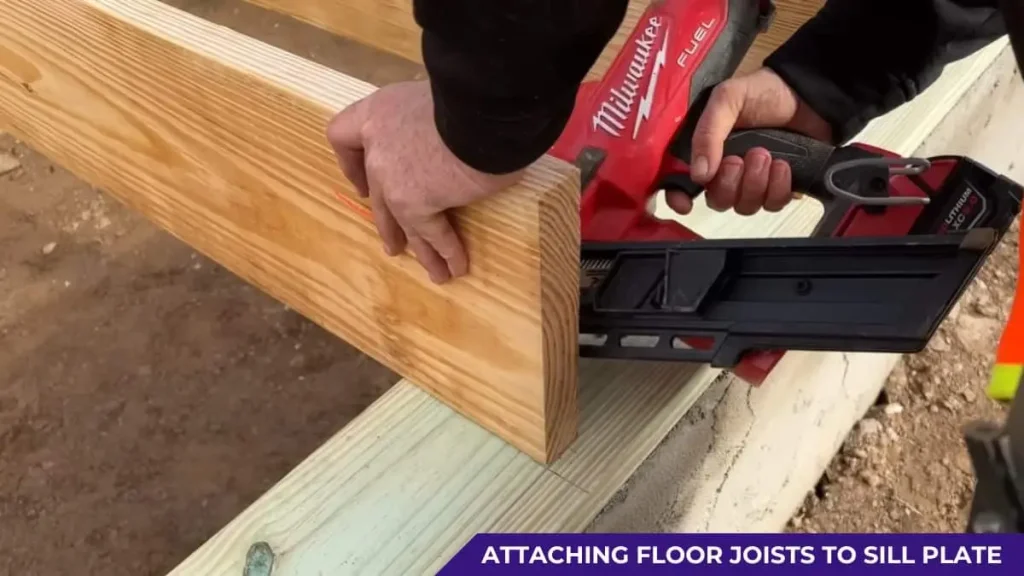
Step-1: Positioning the Sill Plate
Start by ensuring the sill plate is securely attached to the foundation of your structure. This step is essential, as the sill plate serves as the base that supports the floor joists. Typically, anchor bolts are used to fasten the sill plate to the foundation. Check that the sill plate is level and properly aligned with the foundation walls, ensuring a sturdy base for the joists.
Use a carpenter’s level to confirm the evenness of the sill plate. Uneven placement could lead to significant issues later, such as an unstable floor or misaligned joists. If the sill plate is not perfectly level, make necessary adjustments before proceeding.
Step-2: Marking Joist Locations on the Sill Plate
Once the sill plate is in place, the next step is to mark the locations where the floor joists will be attached. Typically, floor joists are spaced 16 inches on center, though 12 or 24 inches may also be used, depending on the building code and the load requirements of the floor. Use a measuring tape and a pencil to mark each joist position clearly on the sill plate.
After marking, use a framing square to ensure that each mark is square to the sill plate. Precise measurements and markings are crucial here, as improper spacing can weaken the structural integrity of the floor system.
Step-3: Installing Joist Hangers
With the joist positions marked, you can begin installing joist hangers. Joist hangers are metal brackets designed to hold each floor joist securely in place. Align the joist hanger with the marks you made on the sill plate, ensuring it is level and positioned correctly. Use a hammer and galvanized nails or a nail gun to fasten the hanger to the sill plate.
Make sure that each hanger is firmly attached and that no part of the bracket is loose. Any movement in the hangers could compromise the connection between the joist and the sill plate, leading to structural weakness over time. For additional stability, use screws alongside nails if local building codes allow.
Step-4: Measuring and Cutting Floor Joists
Before installing the floor joists, measure the distance between the opposite sill plates to determine the correct length for each joist. Use a tape measure and mark the length on the joist. Once the measurements are marked, use a circular saw to cut the joists to the appropriate size.
Ensure that each cut is straight and clean. Inconsistent or rough cuts can lead to poor fitment, which can result in an uneven or unstable floor. Double-check each measurement before cutting to avoid wasting materials.
Step-5: Installing the Floor Joists into the Hangers
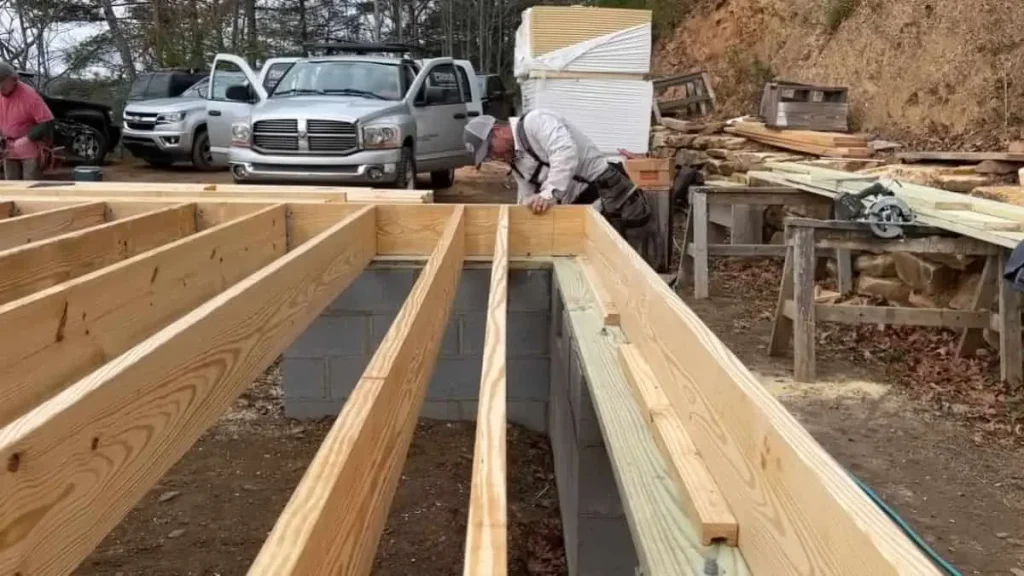
Once the joists are cut to size, place each joist into its corresponding hanger on the sill plate. Ensure that the joist fits snugly within the hanger, with no gaps or movement. You may need to tap the joist into place gently with a hammer or mallet if it’s a tight fit.
After the joist is positioned correctly, secure it to the joist hanger using the recommended fasteners. Typically, this will involve driving nails or screws through the holes in the hanger into the joist. Ensure that all fasteners are driven in fully to prevent any movement over time. Repeat this process for each joist along the sill plate.
Step-6: Securing the Joists to the Sill Plate
In addition to securing the joists within the hangers, it’s important to fasten the joists directly to the sill plate. Use galvanized nails or screws to attach the bottom edge of each joist to the sill plate. This step adds extra stability and ensures that the joists remain firmly in place even under heavy loads.
Check that each joist is level after it is secured. If any joist is not level, you may need to adjust the hanger or shim the joist to correct the alignment. Ensuring that the joists are level is critical to achieving an even floor surface once the subfloor is installed.
Step-7: Checking for Structural Stability
Once all the joists are installed, it’s important to conduct a final check for structural stability. Walk along the installed joists to ensure that there is no movement or shifting. If any joist feels loose, check the fasteners and tighten them as needed. Inspect each joist hanger to ensure that it is securely fastened to both the joist and the sill plate.
Additionally, check the spacing between the joists to confirm that it matches your original measurements. Any variations in spacing can cause problems with the subfloor installation and the overall strength of the floor system.
Step-8: Applying Moisture Barriers or Insulation
In many cases, especially in areas like basements or crawl spaces, applying a moisture barrier or insulation between the floor joists is an important step. Moisture barriers protect the wood from dampness, which can lead to rot and mold growth over time. Insulation helps to regulate temperature and improve energy efficiency in the home.
Cut the moisture barrier or insulation to size and place it between the joists as needed. Secure the material in place with staples or adhesive to ensure it stays in position.
Read Also: How to Reinforce Floor Joists for Plumbing
Best Practices and Expert Tips
Properly attaching floor joists to a sill plate requires attention to detail and adherence to best practices. Following expert recommendations can significantly enhance the quality and longevity of your construction work. Here are some best practices and expert tips to ensure optimal results.
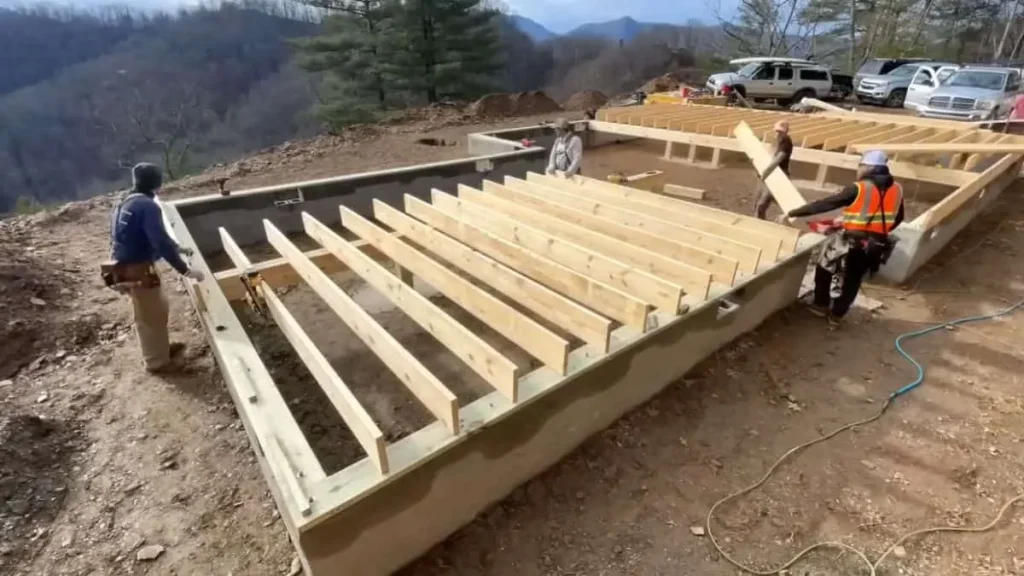
Ensuring Accurate Measurements and Leveling
One of the most critical aspects of attaching floor joists to a sill plate is accurate measurement. Floor joists must be evenly spaced, typically 16 inches on center, but this can vary depending on local building codes and load requirements. Take time to double-check all measurements before cutting any joists.
Additionally, it is essential to ensure that the sill plate and all joists are perfectly level. Use a carpenter’s level frequently throughout the installation process to confirm that both the sill plate and the floor joists are even. A level foundation prevents issues such as uneven flooring, which could lead to structural concerns in the long term.
Using High-Quality Fasteners and Hangers
Another best practice is using the right hardware, specifically fasteners and joist hangers. Experts recommend using galvanized nails or screws to prevent rust and corrosion, which can weaken the structural integrity of the flooring system over time. High-quality joist hangers provide the necessary support to keep the joists securely in place. Avoid cutting corners by purchasing cheaper, lower-quality materials, as this could compromise the stability of the entire structure.
Proper installation of joist hangers is equally important. Each joist hanger should be securely attached to both the sill plate and the floor joist. Make sure that every fastener is fully driven into the wood and that the joist fits snugly within the hanger without any gaps.
Regularly Checking Local Building Codes
Before beginning any construction project, always consult local building codes to ensure compliance with regulations. These codes often dictate the minimum spacing between joists, the type of fasteners to use, and other structural requirements. Following these guidelines is not only essential for safety but also necessary to pass inspections.
In addition to code compliance, local regulations may offer recommendations on enhancing the overall durability and energy efficiency of your flooring system, such as the use of insulation or moisture barriers.
Prioritizing Moisture Protection
Moisture is one of the biggest threats to wood-based structures. Floor joists, which are often located close to the ground or in areas prone to dampness, are particularly vulnerable to moisture damage. Experts recommend applying a moisture barrier between the sill plate and the foundation to protect the wood from absorbing moisture from the concrete.
In addition to moisture barriers, consider using treated lumber for the sill plate and floor joists, especially in areas with high humidity or exposure to water. Treated wood is designed to resist rot and decay, extending the life of the structure.
Inspecting and Rechecking Fasteners
Even after securing the floor joists and attaching them to the sill plate, it’s good practice to recheck all fasteners. Experts suggest inspecting each nail or screw to ensure they are tightly fastened and properly seated. Loose fasteners can lead to movement and instability in the floor joist system.
Over time, as the house settles, it’s possible that fasteners may loosen slightly. A periodic inspection of these fasteners is advisable, especially in areas with fluctuating temperatures or humidity levels that may cause wood expansion and contraction.
Incorporating Insulation and Ventilation
For added energy efficiency, consider installing insulation between the floor joists. Insulating the space between joists can help regulate indoor temperatures and reduce energy costs. However, while insulation is beneficial, it’s equally important to ensure adequate ventilation beneath the floor. Proper ventilation prevents moisture buildup, which can lead to mold and wood rot.
Experts also recommend insulating joists in basements, crawl spaces, or areas exposed to outside elements. Proper insulation not only improves comfort but also protects the structural integrity of the wood.
Minimizing Wood Shrinkage and Warping
Wood shrinkage and warping are common issues when attaching floor joists to a sill plate, especially if the wood is not properly seasoned. Experts recommend using kiln-dried lumber to reduce the chances of wood shrinkage over time. Kiln-dried wood is less likely to warp, ensuring a stable, long-lasting structure.
It’s also important to store lumber in a dry, well-ventilated area before installation. Exposing wood to damp conditions can lead to premature warping, making it difficult to achieve a level and secure flooring system.
Using Blocking or Bridging for Added Stability
Blocking or bridging between joists is a commonly overlooked step that can add significant stability to the flooring system. This technique involves placing short pieces of wood or metal between the joists to prevent twisting or shifting over time. Not only does this add structural integrity, but it also distributes weight more evenly across the floor, reducing the chances of squeaky floors or sagging joists.
Bridging is particularly recommended for floors that will bear heavy loads, such as those in garages or storage areas. It ensures the joists remain straight and aligned, even under pressure.
Related Read: Ductwork Between Floor Joists
FAQs (Frequently Asked Questions)
What is the purpose of attaching floor joists to a sill plate?
Attaching floor joists to a sill plate provides the foundational support for your flooring system. The sill plate, anchored to the foundation, serves as the base where the floor joists rest. This connection ensures stability, allowing the weight of the structure above to be distributed evenly, which is essential for maintaining a safe and level floor.
What materials are recommended for sill plates and floor joists?
For sill plates, pressure-treated lumber is recommended due to its resistance to moisture and decay, making it suitable for ground-level installations. Common choices for floor joists include solid wood (such as Douglas fir or southern yellow pine), engineered wood products (like I-joists or LVL), which provide strength and stability while minimizing the risk of warping or sagging.
How do I ensure proper spacing between floor joists?
Proper spacing between floor joists is typically determined by local building codes, which often require joists to be spaced either 16 or 24 inches on center. Use a measuring tape to mark the desired spacing on the sill plate before installation. Double-check each measurement for accuracy to ensure uniformity and support, as incorrect spacing can lead to structural weaknesses and uneven flooring.
Can I use nails instead of screws for attaching joists to the sill plate?
While nails can be used for attaching joists to the sill plate, screws are generally preferred for their superior holding power and resistance to pull-out. Screws provide a more secure connection and can help prevent joist movement over time. If using nails, ensure they are of adequate size and type, such as galvanized nails, to resist rust and corrosion.
How can I prevent moisture damage when installing floor joists?
To prevent moisture damage during the installation of floor joists, start by using pressure-treated wood for both the sill plate and joists. Install a moisture barrier, like plastic sheeting, between the sill plate and foundation. Ensure proper ventilation in crawl spaces or basements to reduce humidity. Regularly check for signs of moisture and maintain good drainage around your home to protect the wood structure from dampness.
Check Also: Running Romex Through Floor Joists
Conclusion
Attaching floor joists to a sill plate is a crucial step in building a sturdy and stable flooring system. By following the step-by-step instructions, preparation tips, and best practices outlined in this guide, homeowners and DIY enthusiasts can ensure a secure connection that supports the structure above.
Being aware of common issues and understanding how to avoid them will further enhance the integrity of your project. With the right materials, tools, and knowledge, you can confidently tackle this essential aspect of home construction or renovation, creating a solid foundation for your living space.
Whether you are a seasoned builder or a first-time DIYer, this comprehensive guide equips you with the insights needed to achieve a successful outcome.

